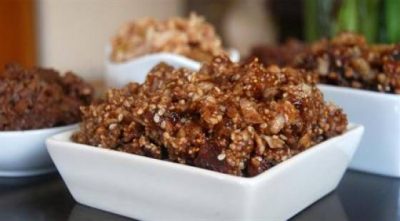Simit (also spelled simeat) are well known throughout the eastern Mediterranean countries, especially Turkey. Despite some differences, they are all shaped as rings and are generously encrusted with sesame seeds. These could very well be the start of what is known today as the Jewish bagel.
The authentic varieties, like Iraqi simit, are closely related to bagels, in that they are poached in hot water before baking.

Simit, the Iraqi bagel on your head
In fact, the name of these pastries originally came from this practice because the root verb samata (سمط) means ‘dip briefly in hot water.’ This is a baking technique deeply steeped in history. In one of the extant medieval Arab cookbooks, a recipe for ring cookies called ka’k instructs that the dough be shaped into rings, which are first carried by a rolling pin and dipped briefly in boiling water and then arranged on a tray and baked in the brick oven called a furn.
In Iraq, simeat are shaped into attractive small twisted rings, encrusted with lots of fragrant toasted sesame seeds, crispy in crust and chewy in texture. They are bought from wandering vendors who arrange the simits on baskets in tall piles and carry them on their
Recipe for simit:
Simit makes an excellent light snack. Here is an easy way to make them without having to parboil them before baking. (Makes 28 pieces)
3 tablespoons dried yeast
2 tablespoons sugar
1 cup (250 ml) warm water
10 cups (2½ lb/ 1.25 kg) bread/strong flour
1 tablespoon salt
¼ cup (60 ml) oil
3 cups (715 ml) warm water
For glaze: 1 egg-white whisked in 1 tablespoon water
Sesame seeds, dry toasted, for sprinkling
1. Oven heat 450°F/ 230°C/ gas mark 8.
2. Dissolve yeast and sugar in 1 cup (250 ml) warm water, and set aside for 5 minutes.
3. In a big bowl, combine flour and salt. Make a well in the middle, and then pour in yeast mixture, oil and 3 cups/715 ml warm water. Incorporate liquids into flour in a circular movement using a wooden spoon. With oiled hands, knead for 6 to 7 minutes until you get a smooth dough. Let rise in a warm draft-free place for about 1 hour.
4. Punch down dough, and divide it into 28 portions. Let it rest for about 10 minutes, covered.
5. On a slightly oiled surface, form into simit rings as follows. Divide each piece into two parts. Roll each part into a rope about 9 in/23 cm long (if dough feels elastic and springs back, let it rest for 5 minutes). Lay 2 ropes next to each other, and wind one rope around the other. Curve twist into a circle, matching ends to form a continuous ring. Make sure to seal the ends very well to prevent them from opening while rising and baking. Put shaped pieces aside on a flat surface. After making about five, brush them with the glaze, and dip each, face down, in the toasted sesame. Arrange rings on a greased baking sheet. Leave space between them to allow for expansion. Repeat with other batches.
6. Let rise in a warm place for 40 to 45 minutes, covered with a kitchen towel.
7. Bake in the middle of the preheated oven. To create a good crust, spray the simit and oven with water. Repeat about 2 to 3 times, for the first 5 minutes. Total time of baking is about 15 minutes or until golden brown. Serve immediately or let pieces cool off in a wicker basket or on a rack. Cooled ones can be kept in plastic bags in the refrigerator or freezer. Heat in the oven as needed.
I sometimes break away from tradition and make simit with cheese, olives and herbs. Quite tasty and aromatic.
Here is how to make them:
 Herbed Simit with Cheese and Olives
Herbed Simit with Cheese and Olives
Prepare dough as given above. After dough rises, punch it down, and add to half of it the following:
¾ cup (4 oz/115 g) pitted/stoned and chopped olives
½ cup (2 oz/60 g) crumbled feta cheese or shredded mozzarella cheese
¼ cup (½ oz/15 g) each chopped fresh mint, parsley, and dill
Knead the ingredients into the dough. Let it rest for 10 minutes, and then divide it into 14 portions. Shape and bake as described above.
This post is by Nawal Nasrallah, author of Delights from the Garden of Eden and more
For more treats from Iraq, try watermelon rind jam, and Iraqi stuffed grape leaves




